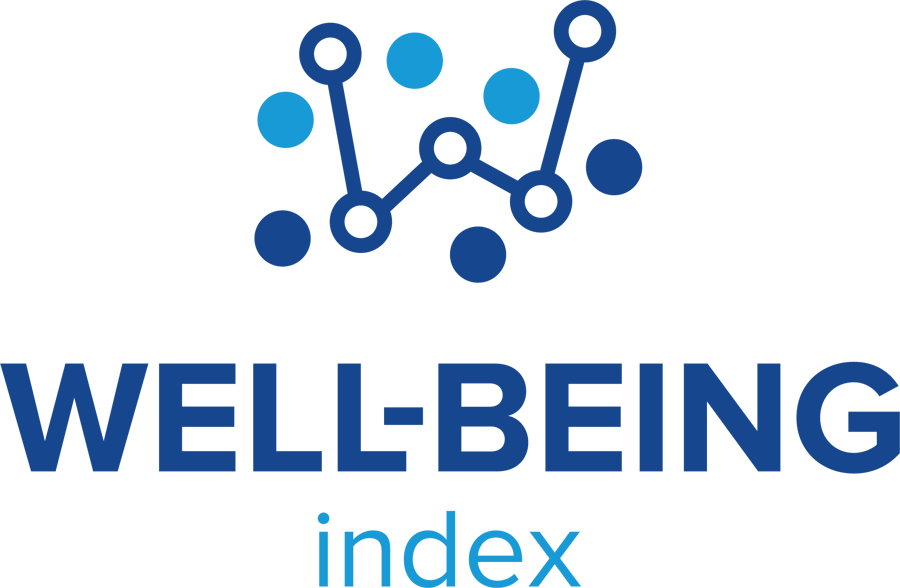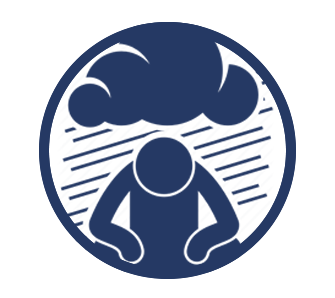Overview of Psychological Distress and Psychological Well-Being
Distress is defined in different ways and can be used in a variety of situations. Psychological distress in the workplace is generally described as an adverse and negative mental state consisting of extreme emotional and psychological pain, anxiety, or sorrow. This mental distress may negatively impact an individual’s level of functioning in both their personal and professional lives. Psychological distress is caused by many factors and can be measured across several dimensions.
Like distress, the term ‘well-being’ can be used in a multitude of scenarios and take on a wide variety of meanings. According to the Centers for Disease Controls, psychological well-being is generally defined as the presence of positive emotions, satisfaction with life, fulfillment, and positive functioning. Emotional well-being and social well-being are important factors in overall workplace well-being.
While the Well-Being Index measures additional dimensions of distress and well-being, including the risk of medical error for certain healthcare providers and dropout risk for medical students, the following six dimensions will be covered in this article:
Learn more about these 6 dimensions of distress and well-being below.
We totally get it. Sometimes it’s easier to read this kind of thing the old-fashioned way.
Download the PDF to read at your leisure.
Why Distress and Well-Being Matter
Throughout the world, mental distress and well-being in the workplace is a topic of great concern. In a 2018 study done by workplace consultant Peldon Rose, it was found that 72% of employees want to work for organizations that champion psychological well-being and mental health at work. The same survey found that workers rated well-being in their jobs as more important than equality, sustainability, and diversity.
Some recent statistics on distress and well-being:
- Only 30% of the U.S. workforce is engaged in their work (passionate about their work and feel strongly committed to their companies)
- 61% of employees are burned out on the job
- 76% of surveyed professionals said workplace stress had a negative impact on their personal relationships
- Suicide is the 10th leading cause of death in the U.S.

In the healthcare industry:
- 79% of primary care physicians experience workplace stress and burnout, an all-time high.
- Each year more than 400 physicians take their lives, likely related to increased depression and burnout.
- Physicians experiencing one or more dimensions of distress are over two times as likely to report major medical errors than those not experiencing distress.
- Approximately $4.6 billion in costs related to physician turnover and reduced clinical hours is attributable to burnout each year in the United States.
Psychological distress and well-being are not only top of mind for employees, but also for employers. According to the Centers for Disease Control and Prevention, distress in the workplace can lead to serious problems for businesses of all kinds.
Poor mental health among employees can negatively affect:
- Job performance and productivity
- Engagement with one’s work
- Communication with coworkers
- Physical capability and daily functioning.

These issues caused by increased mental distress can have long-lasting effects and lead to major repercussions. In the healthcare industry, for example, physician well-being and distress have a large impact on patient care. Physicians experiencing one or more dimensions of distress, such as burnout and severe fatigue, are over two times as likely to report major medical errors than those not experiencing distress. Nurse burnout can often lead to poor relationships with patients, rude bedside manners, and a lack of fulfillment with one’s job.
Hospitals across the country are seeing high turnover rates and staff shortages due to increased nurse burnout and issues with physician well-being. These costly effects can damage every aspect of an organization, from internal culture to the services they provide.
While many organizations have recently been implementing wellness programs, many of these initiatives focus solely on physical health. In order to create a healthy workplace culture and atmosphere, it is important to be able to measure and focus on all dimensions of psychological distress and workplace well-being.
Go Beyond Burnout - Measuring 6 Dimensions
Measure distress and well-being across six dimensions, not just one.
In order to measure and combat psychological distress and promote well-being, Mayo Clinic created the Department of Medicine Physician Well-Being Program and established itself as a leader in the promotion of physician well-being. Experts from multiple specialties, including Internal Medicine, Psychiatry and Psychology, Health Sciences Research and experts in quality of life research conducted numerous national and multi-institutional studies and subsequently developed the 9-question Well-Being Index assessment. Through their studies, these experts identified six dimensions of psychological well-being and distress that would be the basis for their measurement: meaning in work, likelihood of burnout, severe fatigue, work-life integration, quality of life, and suicidal ideation.

After collecting and analyzing data from thousands of U.S. workers and physicians, it was concluded in a 2016 Mayo Clinic study that the Well-Being Index assessment is a successful tool in identifying and measuring mental distress and well-being in individuals across the six dimensions.
While there are many tools that look at only certain dimensions of psychological distress, such as burnout, it is important to measure and track all dimensions of both distress and well-being in order to receive a full and accurate assessment. A comprehensive assessment of mental health is integral in accurately identifying where an individual or organization is most at risk. Only then can a holistic wellness program be put into place.
Along with the need to go beyond burnout, it is necessary to measure the six dimensions with a clinically-validated tool, not a survey. Many surveys claim to be validated by years of research, but it is important to use a clinically-validated tool for the most reliable results and data.
It is also important to be able to track the six dimensions of distress and well-being over time. The ability to track progress across each dimension promotes self-awareness for the participant and gives organizations the ability to evaluate the effectiveness of their wellness programming.
6 Dimensions of Distress and Well-Being
Meaning In Work
Only 30% of the U.S. workforce is engaged in their work (passionate about their work and feel strongly committed to their companies.)

Dimension Overview
Employees who are not feeling fulfilled by their job duties are at a high risk of psychological distress. Individuals who can develop an honest connection to their work are far less likely to experience other dimensions of distress such as burnout.
Dr. Barry Schwartz, former professor of psychology at Swarthmore College and popular TED Talk presenter, states that intrinsic motivation is key in establishing meaning in work. Intrinsic motivation is the drive to act due to an internal reward. In other words, doing something because it is personally rewarding and inherently satisfying rather than driven by an external factor. Many employers manage their organizations based on the long-established notion that intrinsic motivation must only come from individuals’ passions and hobbies and can’t be connected to the tasks they are required to complete at work. In fact, it is the employers that are able to connect a sense of enjoyment and fulfillment to workplace activities that curate the most engaged workforce.
In his books and presentations, Dr. Schwartz also describes the barriers that incentivizing work creates. Organizations that offer incentives for tasks communicate a distrust in their employees, essentially stating that they do not believe the employee will complete the work because it is the right thing to do, and must, therefore, be offered a different benefit. The lack of trust and lack of autonomy created by incentives produces less engagement and meaning in work.
Statistics on Meaning in Work
- Only 30% of the U.S. workforce is engaged in their work (passionate about their work and feel strongly committed to their companies.)
- At least 70% of the variance in team engagement is explained by the quality of the manager or team leader
- Individuals who experience high job strain are at a 45% increased risk to develop Type 2 Diabetes
Increasing Meaning in Work
Effective leadership can create engagement, nurture positive relationships, and connect workers with the organization’s meaningful goals. In addition, managers can match individuals with certain tasks that will better fit with their skillset or desires, improving engagement and fulfillment in work. In an article published by the American Psychological Association, Michael F. Steger, associate professor of counseling psychology and applied social psychology at Colorado State University, states that people find more value in their work when they are able to use their unique talents. Workers who are able to use their skills will feel more connected to the team and valued in the workplace.
In the same article, Jane E. Dutton, Ph.D., a professor of business administration and psychology at the University of Michigan, describes the opportunity for individuals to create their own meaning in any type of work. Through her studies, she has found that individuals can shape their work experiences and develop meaning in three ways:
- Altering tasks
- Workers can add tasks or use existing freedom to allocate more time to tasks that they find deep purpose in.
- Change workplace relationships
- Employees can focus their time and energy on collaborating with other passionate colleagues to develop a shared meaning together.
- Reframe thoughts toward work
- Individuals can change how they see their job duties by connecting them to the bigger mission of the organization.
In a recent Gallup poll, organizations that created a culture of high development experiences and strengths-based competencies reached the highest levels of employee engagement. Cultural shifts in the way organizations operate and manage their employees can lead to increased meaning in work and far less distress.
Likelihood of Burnout
Dimension Overview
Burnout is one of the leading dimensions of psychological distress. In fact, the World Health Organization recently classified burnout as an occupational phenomenon and a legitimate diagnosis, defining it as “a syndrome conceptualized as resulting from chronic workplace stress that has not been successfully managed.” Poor job fit, long working hours, and poor management are just a few of the factors that can lead to overwhelmed employees. It’s important to know the warning signs and actively measure the likelihood of burnout in your organization.
According to a study conducted by Kronos Incorporated and Future Workplace, employee burnout is the biggest threat to building an engaged workforce. It was found that nearly half of human resource leaders surveyed identified burnout as responsible for 20 to 50 percent of their annual workforce turnover.
Burnout in the healthcare setting has become an epidemic. Unreasonable long hospital shifts, greater workloads, increased bureaucratic tasks, poor management, and the toll of constantly witnessing death and sickness have all been shown to lead to nurse burnout. Nurse and physician burnout can have a host of negative impacts on the quality of care provided, from unpleasant bedside manners to major medical errors.

Statistics on the Likelihood of Burnout
In the healthcare industry:
- 79% of primary care physicians experience workplace stress and burnout, an all-time high
- In a 2017 study, 98% of U.S. hospital nurses surveyed reported their work is mentally and physically demanding, and 63% noted that their work has resulted in nurse burnout
- Approximately $4.6 billion in costs related to physician turnover and reduced clinical hours is attributable to burnout each year in the United States
According to 2019 Gallup analysis:
67% of employees say they are sometimes, very often, or always burned out at work
Those who very often or always experience burnout are:
- 63% more likely to take a sick day
- 23% more likely to visit the emergency room
- 2.6 times as likely to leave their employer
Reducing the Likelihood of Burnout
An integral part of reducing the likelihood of burnout in your organization is recognizing the current potential for risk. Like with all dimensions of psychological distress, the ability to identify the signs and measure where you are at is the first step in improving well-being.
Symptoms of employee burnout that you should be aware of include:
- Exhaustion
- Mistakes
- Sickness
- Depression
- Irritability
- Cynicism
- Alcohol or substance abuse

If any of these signs of burnout are affecting individuals within your organization, it is important to take steps to improve workplace well-being.
Using tools like the Well-Being Index for regular assessments of psychological distress and well-being is important in reducing the likelihood of burnout. Consistent screening promotes self-awareness and allows participants to measure progress over time. In addition to regular assessments, the Well-Being Index offers national and internal benchmarking so that participants can compare their results and well-being to averages and learn where they are in most need of help.
The Well-Being Index also offers customizable resources to individuals based on their specific results. It is important to remember, however, that the Well-Being Index is not a diagnostic tool. Organizations experiencing burnout should enact systemic changes and wellness initiatives to fight against distress. In the healthcare industry, there are many resources that institutions can turn to to reduce the likelihood of burnout. Programs such as the American Medical Association STEPS Forward and ACGME-approved Initiatives offer action items and plans for improving wellness and eliminating the negative consequences resulting from burnout and distress.
Severe Fatigue
Dimension Overview
Severe fatigue is more than simply feeling sleepy; it is a dimension of psychological distress that is characterized by severe exhaustion and is commonly related to depression. Common causes include lack of sleep, lack of physical activity, and unhealthy eating habits. Severe fatigue can also be the symptom of prolonged mental work or extended periods of stress and anxiety, and can be intensified by boring or repetitive tasks.
According to Mayo Clinic, the constant state of weariness that is severe fatigue develops over time and reduces individuals’ energy, motivation, and concentration and impacts emotional and psychological well-being. For example, severe fatigue amongst medical providers is commonly caused by increased bureaucratic tasks or unhealthy work schedules and can often lead to poor judgment calls and increased medical errors.
Common effects of fatigue include:
- Decreased task motivation
- Longer reaction time
- Reduction of alertness
- Impaired concentration
- Poor psychometric coordination
- Problems in memory and information processing
- Poor judgment
Closely related to severe fatigue is compassion fatigue, defined as stress resulting from exposure to traumatized individuals. Healthcare providers, emergency responders, and community service workers are common examples of individuals affected by compassion fatigue.

Statistics on Severe Fatigue
A study published in the Journal of Occupational and Environmental Medicine found that:
- 65.7% of workers with fatigue reported health-related lost productive time compared with 26.4% of those without fatigue
- Workers with fatigue cost employers more than $101 billion annually in health-related lost productive time
In the healthcare industry:
- In a 2017 study of registered nurses in U.S. hospitals, 85% of those surveyed noted that their nursing jobs make them fatigued overall
Reducing Severe Fatigue
Many strategies can be put in place by both organizations and individuals to manage and reduce severe fatigue. In a study published in the Industrial Psychiatry Journal focusing on fatigue in the workplace, it was determined that strategies to reduce fatigue can be split into two categories: preventative strategies and operational strategies. Preventative strategies are used between working hours and include minimizing sleep loss and maintaining healthy habits at home. Operational strategies are used on the job and can be implemented by an organization, such as naps during night shifts.
Organizations can implement a variety of measures to combat worker fatigue, such as providing improved environmental conditions, shortening or eliminating night shifts, reducing the number of consecutive days employees must work long shifts, and limiting early morning starts.
As with other dimensions of distress, active monitoring and education are vital in reducing the effects of severe fatigue. Management should be trained on the signs and strategies to reduce fatigue, and workers should be educated on the importance of managing their well-being and the negative effects that ignoring distress can have.
Work-Life Integration
Dimension Overview
Work-life integration can be defined as an approach that creates synergy between all areas that make up one’s life, including their career or profession, home and family, and community. Work-life integration has largely replaced the concept of work-life balance, as these areas of one’s life can rarely be separated. Rather than placing each aspect on a scale and attempting to determine if they are balanced, the work-life integration approach views life and work holistically. The measurement of this dimension aims to discover how successfully an individual is creating the optimal engagement, fulfillment, and well-being from their entire being. A healthy mix and integration between all aspects of one’s life has a profound impact on their state of psychological well-being.
The traditional line drawn between work and personal life continues to blur. Advances in technology have made it easier than ever before to stay in constant communication and manage all areas of life at all times. In fact, younger generations of workers intentionally try to blur the line and integrate their professional and personal lives, seeking a deeper purpose and meaning in their overall experience.
Changes in the workplace culture have altered workers’ expectations over time. The traditional work environment has changed dramatically for some, from what they wear to the hours they work, and it changes the way people think about their lives. Today, employees desire and expect greater autonomy. While nontraditional work cultures have been shown to be beneficial in some situations, they may also allow for greater opportunity of distress in others. Nurses, for example, are expected to work increasingly long hours.
Statistics on Work-Life Integration
- 87% of employees expect their employer to support them in attending to work and non-work areas of their lives
- 42% of working Americans say they take care of personal or family needs during work and 48% report regularly responding to work communications during personal time
In the healthcare industry:
Nurses working shifts of 10 hours or longer were associated with worse reports of patient care quality and overall safety grade compared with nurses working 8 to 9 hours.
Improving Work-Life Integration
In order to create a work-life integration that works, individuals must actively check in with themselves on a regular basis. The Well-Being Index allows organizations to evaluate their employees’ well-being toward work-life integration and adjust internal culture, schedules, and policies accordingly. Consistent monitoring also promotes self-awareness in participants.
Improving Work-Life Integration
In order to create a work-life integration that works, individuals must actively check in with themselves on a regular basis. The Well-Being Index allows organizations to evaluate their employees’ well-being toward work-life integration and adjust internal culture, schedules, and policies accordingly. Consistent monitoring also promotes self-awareness in participants.
Along with regular check-ins and reflection, employers can offer benefits that make it easier for workers to develop a work-life integration that works for them. In a 2019 Gallup article, it was reported that increased employee benefits such as the amount of vacation time they receive and flexible scheduling can account for higher levels of engagement and workers’ satisfaction.
Other dimensions of psychological well-being can also play an important role in improving work-life integration. Results of a work-life survey conducted by the American Psychological Association suggest that work-life fit is primarily driven by the extent to which people identify with their work role. If an individual is experiencing a greater meaning in work, they are more likely to maintain a positive work-life integration.
Quality of Life
Dimension Overview
Mental quality of life is an important dimension of both distress and well-being. The Well-Being Index identifies both a high or low mental quality of life in individuals as part of their overall well-being assessment. Factors in a participant’s personal and professional life play a role in measuring their quality of life.
Increased exposure to high-stress environments and situations will threaten the quality of life in individuals. The American Psychological Association states that workplace stressors have a significant impact on workers’ overall health. Stress experienced, as well as stress perceived, have been shown to negatively affect an individual’s psychological well-being. For example, college and graduate students, especially medical students, are often subjected to unhealthy and stressful conditions while completing their schooling. According to the American Medical Student Association, this distress is due to a variety of reasons. Increased competition, intense workloads, limited time to seek treatment, and the stigma attached to treating distress all factor into a lower quality of life for medical students.
In a quality of life study among student groups conducted by the Centre for Medical and Health Sciences Education at the University of Auckland, New Zealand, it was found that all university student groups appeared to be experiencing a decreased quality of life. Furthermore, the medical student group scored lower than the reference group in psychological health, physical health, and environmental quality of life domains.
Statistics on Quality of Life
- As many as one-third of medical students have some form of depression
- In a national study of over 16,000 internal medicine residents, overall quality of life was classified as being “as bad as it can be” or “somewhat bad” by 14.8% of residents
- 76% of surveyed professionals said workplace stress had a negative impact on their personal relationships

Improving Quality of Life
Some organizations have found success in implementing incentivized wellness and exercise programs to combat distress and improve quality of life. The Mayo Clinic in Rochester, Minnesota, developed an elective, team-based exercise program to test the effects among residents and fellows. After the 12-week program was completed, researchers found that participants reported a higher quality of life than non-participants who had the same access to exercise facilities.
In another study published by Mayo Clinic Proceedings, 100 employees completed a 12-week wellness coaching program to test the effects in three areas of psychosocial functioning: quality of life, mood, and perceived stress level. Those who completed the wellness coaching program displayed significant improvements in all three areas, and after 24 weeks maintained the improvements.
Suicidal Ideation
Dimension Overview
Suicide is a serious public health issue and suicidal ideation is one of the most important dimensions of psychological distress to measure consistently. The Well-Being Index measures the risk of suicidal ideation in participants as part of their overall distress and well-being. The measurement of this dimension of mental distress is not an evaluation or diagnosis, but instead an assessment of the potential risk of suicidal thoughts if no changes are made to the individual’s well-being.
Knowing the signs and consistently measuring the likelihood of developing suicidal thoughts are important steps in reducing the risk of suicidal ideation.

Some signs of suicidal ideation in the workplace include:
- Isolation at work
- Poor job performance
- Sudden change in an employee’s personality
- Previous suicide attempts or threats
- Expressions of hopelessness or depression
- Lack of interest in the job
- Signs of other dimensions of distress such as burnout or fatigue
Statistics of Suicidal Ideation
- Each year more than 400 physicians take their lives, likely related to increased depression and burnout
- Suicide is the 2nd leading cause of death among people aged 10-34 in the U.S.
- Suicide is the 10th leading cause of death in the U.S.
- 800,000 people die due to suicide every year
- There were more than twice as many suicides (47,173) in the United States as there were homicides (19,510) in 2017
Preventing Suicidal Ideation
While suicide is a major public health risk, the World Health Organization states that suicides are preventable with timely, evidence-based, and often low-cost interventions. WHO’s suicide prevention approach is know as LIVE LIFE, and delivers a guideline for how larger strategies should be developed. The comprehensive approach revolves around leadership, interventions, vision, and evaluation.
Resources like the Suicide Prevention Lifeline also aim to advance suicide prevention by:
- Empowering individuals
- Advancing professional best practices
- Building awareness
Making sure that managers and leaders are properly trained in identifying suicidal ideation and intervening is a crucial step in preventing suicide. Leaders need to know what to do when individuals in the organization are displaying the signs. Avoiding or eliminating any form of stigma, including the individual socially, and providing appropriate resources are just a few examples of interventions that management should be thoroughly trained in.
How to Reduce Psychological Distress and Improve Well-Being
The first step in reducing distress in your organization is measuring your current state. In order to know where to invest resources or plan interventions, you must identify the specific areas that you are most at risk.
The Well-Being Index gives organizations a detailed and ongoing report of their employees distress and well-being by providing:
- Specialty and Departmental Segmenting
- National and Internal Benchmarking
- Customized Data Analysis
- Resource Access Reporting
- Participant Feedback

Once an accurate picture is drawn of where you stand as an organization, specific wellness programs and initiatives can be implemented to target the areas where you are at most risk.
Routinely assessing your current state of distress and well-being is a vital step in improving your mental and emotional health. Checking in on your social and emotional well-being with a self-assessment tool provides many benefits to overall health and wellness and lets organizations know if the wellness plan they have enacted is working.
In addition to using the right tools, it is necessary to ensure buy-in from management and leadership. Senior-level support is vital in ensuring the successful rollout of wellness initiatives throughout the organization. To help with creating this buy-in, the Well-Being Index offers an Executive Leadership Info Kit that contains leadership summaries, an overview booklet, validation articles, contact information, and other helpful links. Sharing web pages such as this one will also help establish the importance of implementing institutional-wide well-being initiatives and interventions.
In order to improve psychological well-being, it is necessary for individuals to treat their mental and emotional health in the same way as their physical health. Routine checkups are an important part of monitoring and improving overall wellness. In order to systematically reduce mental distress and improve well-being, organizations must equip their employees with the tools and resources they need.
What Others Are Doing to Improve Well-Being
With well-being becoming an increased focus for professionals and their employers, many organizations have been implementing comprehensive initiatives and unique wellness interventions to reduce the negative consequences that come with distress. Once the current state of psychological distress and well-being within an organization has been accurately measured and reviewed, measures can be put in place to improve the culture and atmosphere. In the healthcare industry, many institutions have developed successful strategies to combat distress and promote wellness among their physicians, nurses, residents & fellows, employees, advanced practice providers, and medical students.
The Accreditation Council for Graduate Medical Education (ACGME) has created a long list of programs and collaborations that aim to promote well-being among healthcare professionals. The Back to Bedside initiative encourages relationship building between providers and patients to combat burnout and increase meaning in work. It is just one of many programs that strive for a greater emphasis on well-being. Medical schools and institutions around the world are recognizing the work that needs to be done to improve the lives of those who provide for patients. Interventions that can be implemented internally have proved to greatly reduce distress, increase retention, reduce performance problems, and increase patient satisfaction. Providing on-site counselors, encouraging management education, increasing delegation and teamwork, and increasing daily interactions are just a few examples of interventions that have been shown to reduce nurse burnout and fatigue.
Other organizations are developing even more creative ways to promote well-being and reduce psychological distress. The University of Minnesota Medical School has recently implemented an experimental housing system for its students similar to Harry Potter to reduce the likelihood of burnout before students even become practicing doctors. Three learning communities make up the housing system, in which students are placed at the start of their schooling. These communities offer medical students a greater sense of community, access to academic resources, and increased connection to advisers.
Industries outside of healthcare are also making changes to focus on well-being. Companies are now understanding that offering a wellness program outside of work that only focuses on physical health is not enough to ensure the complete well-being of their employees. Many organizations are implementing physical changes to the workplace to promote psychological well-being. In fact, recent studies show that 70% of employers have improved their physical environments to encourage healthy behaviors. From air quality and lighting to the colors and design concepts used in organizing a workplace, many elements of physical environments have an impact on mental health and well-being.


Final Thoughts
Employers in all industries must make well-being a top priority and not an after-thought. It is not just important to improve the lives of those working at your organization, but it is a vital strategy for success. Promoting well-being and reducing the negative consequences associated with distress will prove beneficial for all involved and lead to happier, healthier lifestyles.
Explore the Well-Being Index Demo
Join 600+ organizations already using the Well-Being Index. Invented by Mayo Clinic, the Well-Being Index:
- Anonymously measures 6 dimensions of distress and well-being in just 9 questions.
- Allows participants to compare their results to peers’ and national averages.
- Provides customized resources based on an individual’s results designed to reduce distress.
- Includes the ability to track well-being over time.
The Well-Being Index is available in multiple plans to ensure organizations of all sizes can utilize the tool.
